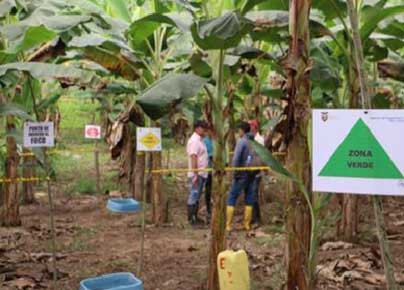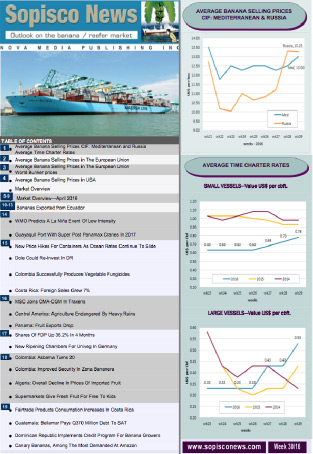Ecuador: Moko Severely Affects Banana Plantations in Los Ríos
2024-07-19

A resurgence of Moko in the Ecuadorian banana-producing province of Los Rios raises alarms about the rapid spread of this disease. It appeared over a decade ago in El Carmen in the province of Manabí, but what seemed to be only a problem for plantain crops is now also affecting bananas.
The spread of the bacteria is raising alarms in this industry, the country's second source of non-oil foreign exchange. The concern is the rapid pace at which this disease, which wilts and reduces plant productivity, could spread.
The Agency has provided the figures for Phytosanitary and Zoosanitary Regulation and Control (Agrocalidad), which reflects an outbreak of affected crops.
In Los Ríos, it is estimated that there are about 70,000 hectares of bananas, of which the Agency has managed to check 30,000 hectares. Preliminary results show that at least 8% of those inspected crops (about 2,400 hectares) are infected, a percentage well above the 2.45% reported in 2023.
Patricio Almeida, director of Agrocalidad, told the local press that this percentage may vary as the monitoring sample continues to expand, an inspection task that, from this month, is conducted by twenty technicians, with the help of 18 drones.
Ángel Llerena, a doctor in Agricultural Sciences and a research professor at the Catholic University of Guayaquil (UCSG), is concerned about the rapid spread of this disease, caused, he explains, by the bacterium Ralstonia solanacearum race 2, which wilts the plants, preventing them from producing their fruits.
He attributes the problem solely to the need for more effective control. "This is disastrous because Agrocalidad, which is responsible for taking precautionary measures, unfortunately, has not fulfilled effective control, which has caused this bacterium to spread in banana areas, not only in Los Ríos but also in other provinces of the country."
Franklin Torres, president of the National Federation of Banana Producers, shares a similar view, believing the problem could be more significant than announced. "Considering all the reports we have from various provinces; we are talking about nearly 20,000 hectares lost nationwide due to this disease and about 40,000 hectares affected and at risk if there is no adequate phytosanitary control to allow recovery." Of these 20,000 hectares estimated, at least 15,000 would be in Los Ríos and its surroundings, which has already started to affect production. "In this province, up to 200,000 fewer boxes are reported, which represents dozens of containers less from all the areas that may not bear fruit in the next six months, and when replanted, it could take at least another year to produce. This is if the results of these quarantines are effective."
On the other hand, Patricio Almeida, Director of Agrocalidad, views with scepticism the unofficial figures that are being disclosed, which differ significantly from Agrocalidad's reports, which so far have recorded the presence of moko only in three hectares of a farm in Arenillas (El Oro Province) and just a few plants found in Tenguel (Guayas Province). There is also infection in the Oriente, Esmeraldas, Santo Domingo, and Bolívar areas. Still, he clarifies that these are isolated cases recorded on crops for self-consumption, not commercial-scale plantations.
In Manabí, where it all started, the disease has stayed in plantain plantations in the El Carmen area, with an incidence of 3%. "These are real data because we have gone to the field. We would have to see how substantiated the figures of the leaders who refer to the issue are. They are talking about 40,000 hectares, but there is no evidence of such number of areas affected," he said.
From his side, Richard Salazar, executive director of the Association of Marketing and Export of Bananas of Ecuador (Acorbanec), clarified that less than 3,000 hectares have been detected with the pest. He emphasized that preliminary unofficial information suggesting 40,000 hectares were affected was wrong.
"Moko is an issue in the plantations, but it seems irresponsible to the person who mentioned that there are 40,000 hectares affected by Moko, which is incorrect.
Almeida attributes the problem in Los Ríos to the floods that occurred at the end of last year and the beginning of this year. "The bacteria are transported through water, and many areas of Los Ríos were affected, which is why we see this correlation with the infestation." About the level of responsibility that Agrocalidad would have, the official points out that none since the entity has stopped monitoring this disease. The control deficiencies, he says, lie with the farm owners themselves, who are not applying biosecurity protocols. A lousy practice they try to counteract with training.
But for Torres, that is not enough. He says more significant state intervention is needed. Today, producers need credits to provide maintenance that is not given on the farms during crisis periods. "When a farm does not have enough channels, total waterlogging of the banana plantation occurs, which causes bacteria or fungi to affect production," he says.
Agrocalidad also attributed the resurgence of moko to the floods recorded at the end of last year and the beginning of this year and cited that another factor is the disregard for biosecurity policies within the farms. Floods cannot be controlled, but biosecurity can. In this sense, experts recommend not allowing vehicles and people to enter without prior disinfection, training workers on the use and disinfection of tools, and not using material from uncertified sites.
If an infected plant is detected, a protocol to prevent its spread is recommended. This includes notifying Agrocalidad when a plant shows symptoms (yellowing of its leaves), performing a soil eradication and disinfection procedure, and letting it rest for a prudent time before replanting.









